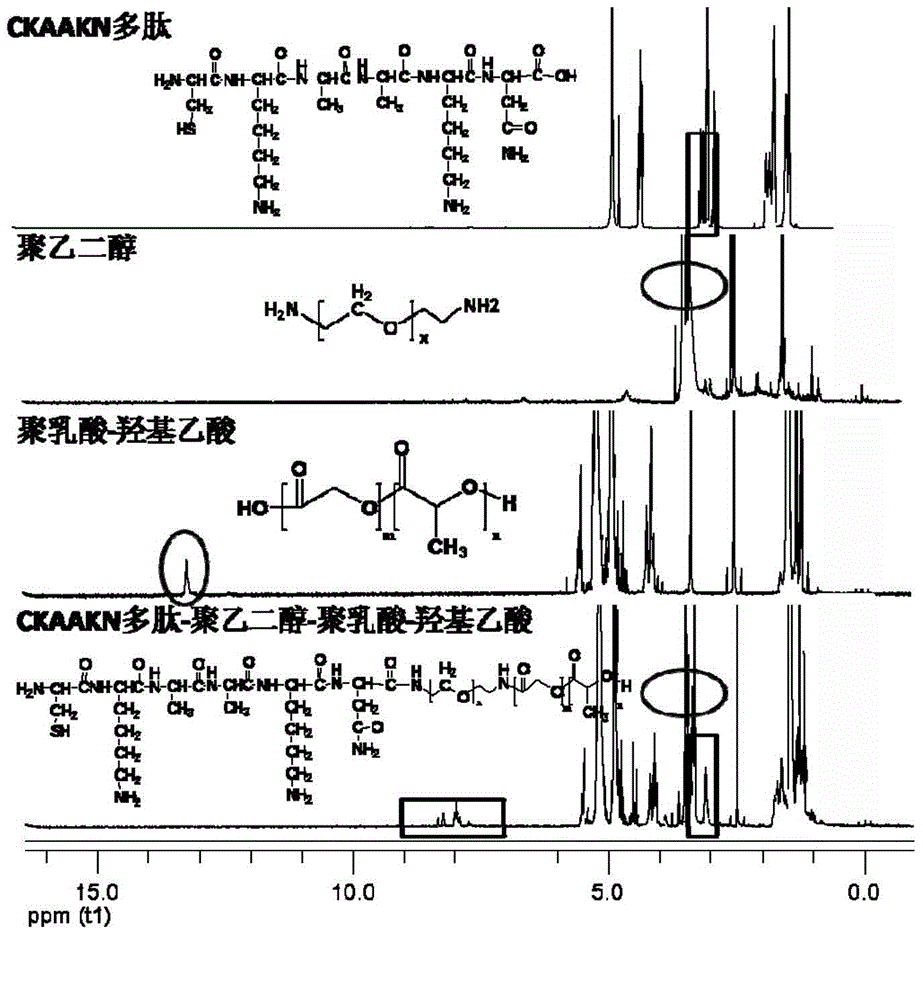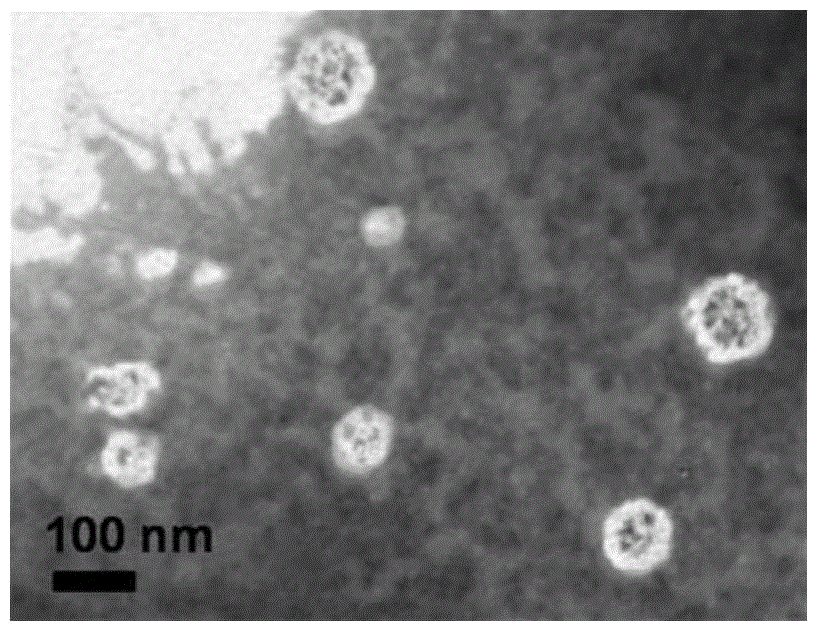Targeted polymer micelle magnetic nanoparticle, and preparation method and application thereof
A technology of magnetic nanoparticles and polymer glue, applied in drug delivery, preparations for in vivo tests, emulsion delivery, etc., can solve the problem of difficult diagnosis of pancreatic tumors, and achieve the effect of improving the ability of independent innovation
- Summary
- Abstract
- Description
- Claims
- Application Information
AI Technical Summary
Problems solved by technology
Method used
Image
Examples
Embodiment 1
[0025] Embodiment one: Synthesis of CKAAKN-PEG-PLGA grafts
[0026] Dissolve commercially available polylactic acid-glycolic acid (PLGA, Mw: 8000) in a certain amount of dimethyl sulfoxide (DMSO, Mw: 78.13) solution, add a certain amount of N,N'-dicyclohexylcarbodi Imine (DCC, Mw: 206.18) and N-hydroxysuccinimide (NHS, Mw: 115.09) were reacted with magnetic stirring at room temperature for 24 h under the protection of argon, and slowly added dropwise a certain amount of polyethylene glycol ( PEG, Mw:1500) in DMSO solution, continue to react for 6 h, then dissolve with acetone (concentration: 20mg / mL) after dialysis, centrifugation, and freeze-drying, then redissolve with deionized water, and obtain PEG- PLGA copolymer. Dissolve an appropriate amount of PEG-PLGA copolymer, CKAAKN polypeptide and DCC in a certain amount of DMSO solution, and react with magnetic stirring for 8 hours at room temperature, mix with a certain amount of deionized water, dialyze, centrifuge, and dry...
Embodiment 2
[0029] 1. Preparation of polymer micellar magnetic nanoparticles and determination of their physical and chemical properties
[0030] CKAAKN-PEG-PLGA-USPIO was prepared by solvent diffusion and dialysis. The specific method is: a certain amount of oil-soluble Fe 3 o 4 (particle size 5 nm, concentration 5 mg / ml) magnetic nanoparticle solution as the core was ultrasonically dispersed in F-68 solution (Poloxamer 188, 0.1 %, w / v), and the probe was continuously ultrasonicated for 30 min (600 w, After working for 2 s and resting for 3 s), 10 mg / ml oleic acid ethanol solution was added, and the probe was sonicated for 5 min to obtain Fe 3 o 4 nanoparticle dispersion. Weigh a certain amount of CKAAKN-PEG-PLGA and dissolve it in an appropriate amount of deionized water; under the condition of ultrasonic stirring, add a certain amount of Fe 3 o 4 The nanoparticle dispersion was subjected to continuous ultrasonication for 10 min, and then rotary evaporated in a water bath at 60°C ...
Embodiment 3
[0043] Embodiment three: MRI Scanning of Polymer Micellar Magnetic Nanoparticle Samples
[0044] The magnetic susceptibility of the polymeric micellar magnetic nanoparticles was measured by measuring the change in the T2* relaxation time of the magnetic resonance scan. The prepared polymer micellar magnetic nanoparticle suspensions with different concentrations (0, 1, 10, 15, 25, 50, 75, 100 μg / ml) were respectively filled into 2.0 ml Eppendorf tubes, placed in water-filled In a test tube box, the scan was performed with an eight-channel head coil under GE 3.0T whole-body magnetic resonance.
[0045] see Image 6 , the results show that with the increase of the final iron concentration in the polymer micelle magnetic nanoparticle suspension on the ESWAN image, the T2* signal intensity gradually decreases, indicating that the polymer micelle magnetic nanoparticles prepared in this experiment have negative reinforcement. Effect, that is, within a certain concentration range,...
PUM
| Property | Measurement | Unit |
|---|---|---|
| particle diameter | aaaaa | aaaaa |
| concentration | aaaaa | aaaaa |
| particle diameter | aaaaa | aaaaa |
Abstract
Description
Claims
Application Information
 Login to View More
Login to View More - Generate Ideas
- Intellectual Property
- Life Sciences
- Materials
- Tech Scout
- Unparalleled Data Quality
- Higher Quality Content
- 60% Fewer Hallucinations
Browse by: Latest US Patents, China's latest patents, Technical Efficacy Thesaurus, Application Domain, Technology Topic, Popular Technical Reports.
© 2025 PatSnap. All rights reserved.Legal|Privacy policy|Modern Slavery Act Transparency Statement|Sitemap|About US| Contact US: help@patsnap.com



